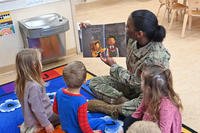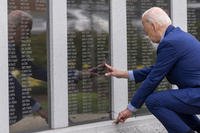Beginning this fall, soldiers across the Army will have a year to bone up on physical fitness in order to ace the challenging new six-event Army Combat Fitness Test, which will become the required standard across the service by October 2020. But Army officials say they still plan to make some final adjustments to grading and standards based on early testing results.
The Army is now about eight months into year-long field test of the ACFT involving 63 battalions of active, National Guard and Reserve soldiers.
"It's going well ... we have some very good results," Sergeant Major of the Army Daniel Dailey recently told an audience at an Association of the United States Army breakfast.
Once the field test is complete in October, soldiers across the Army will begin taking the ACFT for practice only until October 2020, when the ACFT officially replaces the current Army Physical Fitness Test (APFT).
"Units will be taking it and they will be assessed on their performance, but not for attribution during that time period," Dailey said. "I remind people when we go into this, you are going to see some leveling out on the scores and people are going to go, 'oh, you made that easier.' That is not true; this is normal. We changed the APFT scores throughout its history five or six times.
"So, what you are going to see over time is you are going to see scores increase as soldiers build strength and endurance in each one of these events."
The Army released the initial set of standards for passing the ACFT last August.
Michael McGurk, director of research for the Center for Initial Military Training, the organization overseeing the new ACFT, told Military.com that the Army is planning on publishing a different set of standards sometime this fall.
"So, there will be some very minor adjustments," McGurk said. "We will look at where we set the initial levels and determine based on the results of the field test -- 'hey, did we aim too high, or too low, or about right?'"
McGurk added that, "across the board, we are about right."
"So, if I say 'hey, look it's not 180, its 185; it's not 30 pushups, its 27' -- it's going to be minor changes, but I think there are all very close to where we need them," McGurk said.
McGurk agreed with Dailey that the Army has adjusted the standard on the APFT many times over the past four decades.
"If you look at the standards from 1980, I think we changed them seven times over the 40 years ... and almost every time we changed them, they went up, not down," McGurk said.
Much of the field test involves refining how the new ACFT will be administered.
"We are working really hard to get the instructions, specific, relevant, gradable and enforceable," McGurk said.
In the leg tuck event, for example, part of the instruction states that the arms have to be flexed, he said.
"How much do your arms have to flex? Do they have to flex 10 degrees, 15 degrees, 30 degrees, 90 degrees?" McGurk said. "And is that a measurement that somebody can measure exactly?"
"So ... in the regulation we have to write, flex of the arm means that the arm goes from the fully extended position to a flexed position. The degree of flex is up to the individual soldier to decide upon, as long as the knees touch the elbows on both sides."
Dailey said feedback from soldiers conducting the field test has helped fitness officials refine many aspects of the ACFT.
"We are already making some slight changes and tweaks based upon what the soldiers are telling us about the test and how we grade it, how we are going to administer it, the amount of time it takes, the amount of equipment it takes," Dailey said.
"And those are all resources, things that we need answers to before we go live."
-- Matthew Cox can be reached at matthew.cox@military.com.












